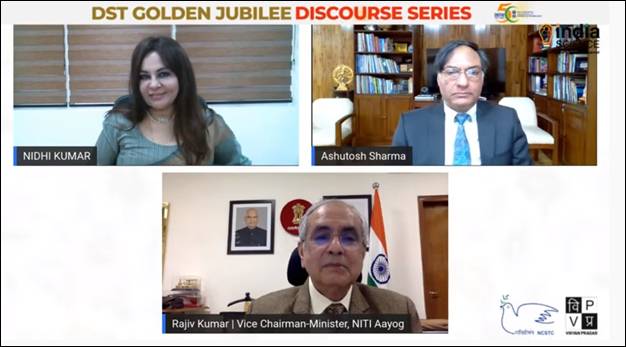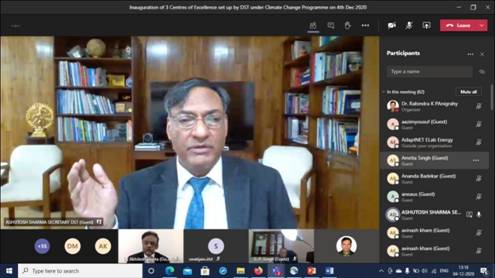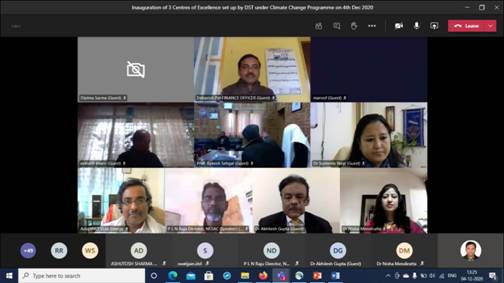Vice-Chairman, NITI Aayog, Dr. Rajiv Kumar, emphasised that the Indian economy will be among the top economies in the world in the next few years using science, technology, and innovation in all sectors, bouncing back soon from the after effects of COVID 19, at a webinar organized to celebrate 50 years of the Department of Science and Technology (DST) recently.
“Steps and reforms have been taken by the Government in all the sectors, like agriculture, modern medicine, traditional medicine, New Education Policy, Small & Medium Enterprises, labour sector and so on, to target being among the world’s top three economies ,” he said at the webinar on DST Golden Jubilee Discourse Series – On the other side of the Pandemic – organised by National Council for Science & Technology Communication and Vigyan Prasar.
He said that the pandemic has changed many things and shown new ways of doing things and many of these are going to stay in the post-COVID world, and we need to have an innovative economic system in the post-COVID world to remain floating.
Dr. Kumar added that the economy post-COVID has been in the recovery mode after the first quarter and hoped that Indian economy will bounce back in next few quarters from the effects of COVID-19 disruptions, will grow by average 7-8 percent in next 20-30 years and become the third-largest economy by 2047.
Talking about the structural reforms by the government to help Indian economy compete with the best of the world, Dr. Kumar said, “The government is committed to improving the ease of doing business, innovation ecosystem where every school student has access to the innovative tools and trends.”
Speaking at the webinar, DST Secretary Prof Ashutosh Sharma highlighted the various steps DST has taken to help Indian economy grow at the desired rate by using science, technology, and innovation in all fields like clean energy, health, education, transport, agriculture, communication, electric mobility, electric storage, quantum technologies and so on. He also talked about the steps DST has taken to give flexibility to scientists to deliver the desired results for technology missions and steps taken to help increase the number of startups using innovation, science, and technology.
“DST in the last 50 years has done a lot of building of capacity, in all areas. India is number three in science publication in the world, and DST has a great role in it. Our last 50 years has been glorious, but our next 50 years should exceed the last 50 years. Our budget has doubled in the last five years, and it allows us to chart new directions. While keeping all the basic research and development in place and enhancing it, we have introduced a problem-solving approach to research. We are ready for the future, and there is a whole lot of new emphasis on innovation and startups and new models of innovation”, Prof Sharma said.

Meanwhile, three Centre of Excellence (CoE) set up under National Mission for Sustaining the Himalayan Ecosystem (NMSHE) at Central Universities from two North-Eastern states, and Kashmir were inaugurated by Secretary Department of Science & Technology (DST) Professor Ashutosh Sharma, recently through Video Conferencing.
Professor Sharma urged these centres to lead the climate change research in the Himalayan region while inaugurating the centres at the University of Kashmir, and Sikkim University and Tezpur University that have been established by the Department of Science and Technology (DST). He highlighted the importance of focusing on relevant interventions in this region which is the third pole and is both a contributor to climate change and regulator of it.
He stressed that the centres should be the primary movers of producing knowledge and also using that knowledge with the help of appropriate stakeholders and also be a source of motivation for Himalayan Universities to come forward to take up research challenges.
“Out of the 8 national missions which are part of the National Action Plan on Climate Change, NMSHE is the only site-specific mission that aims to take suitable measures for safeguarding the Indian Himalayan Region. With capacity building the major focus of NMSHE, we have set up Climate Change (CC) cells in 12 out of the 13 states and Union territories of Himalayan region and will soon have 13th state CC cell in Ladakh,” he added.
Prof. S.P. Singh, Chairman Expert Committee of DST on Climate Change programme appreciated the setting up of the centres in the two parts of the Himalaya and said: “DST has played a proactive role as co-developers of the projects and activities in this mission and is taking a corrective measure by giving importance to universities of the Himalayan region to boost their research.”
“The Himalayan region offers several systems where research can be done, whether it is glaciers, forests or alpine meadows. We should take advantage of these systems which offer a system to answer many of the questions and are of global interest,” he pointed out.
Dr Akhilesh Gupta, Adviser and Head, SPLICE-Climate Change programme DST explained that in order to drive the research leadership in the 145 Universities in the Indian Himalayan region and address challenges like inadequate R&D infrastructure especially in climate change, lack of quality manpower and encourage institutional centric research, a thorough mapping based on capacity building requirement was done by DST. The three CoEsset up at Kashmir, Tezpur and Sikkim Universities were part of outcome of this mapping exercise.
Prof. Talat Ahmad, Vice-Chancellor Kashmir University, pointed out that there are more than 13,000 glaciers in the Himalaya and study of these need development of a large workforce with expertise in this field.
Prof. V. K. Jain, Vice-Chancellor, Tezpur University underlined the necessity of a centre in the Northeast which is home to a significant proportion of the tribal community with a need to deal with issues related to their sustainable livelihood.
Prof. Avinash Khare, Vice-Chancellor Sikkim University said this CoE will help in the capacity building of the Sikkim University by strengthening fieldwork and other research and infrastructure facilities.
Dr Nisha Mendiratta, Associate Head SPLICE-Climate Change programme DST said that NMSHE seeks to facilitate the formulation of appropriate policy measures and time-bound action programmes to sustain ecological resilience and ensure the continued provisions of key ecosystem services in the Himalaya, evolving suitable management and policy measures for sustaining and safeguarding the Himalayan ecosystem.


